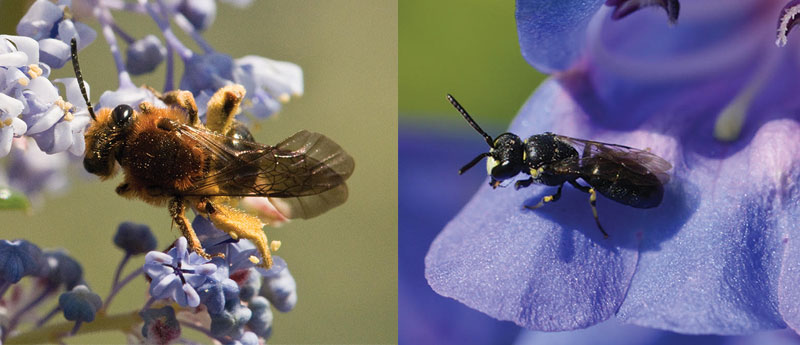We’ve all heard the popular slogan, “Save the Bees!” Responsible for essential pollination services in the ecosystem, bees are key contributors to the continuation of life on Earth. Without them and other pollinating insects, flowering plants would cease to reproduce themselves, destroying our ability to farm for essential foods, and sending our wild lands into a state of ecological collapse.
Yet, conversations regarding bees tend to center around the ubiquitous European honeybee, a now-naturalized agricultural import, and neglect our numerous wild, indigenous species. In fact, most people are completely unaware that, in the United States, there are roughly 4,000 species of native bees. Prior to the European introduction of the honeybee in the 17th century, these native bees were responsible for sustaining life for millions of indigenous people, plants, and animals. 1,600 different bee species currently reside in California, with several hundred of those making their home in Griffith Park.
The diversity of our native bees is fascinating. Unlike honeybees, our wild bees do not produce honey. Most are solitary and nest in bare, open ground (e.g. mining bees, sweat bees, digger bees), or in wood and other cavities (e.g. mason bees, carpenter bees, leaf-cutting bees, masked bees). Many are incapable of stinging, and those that can sting, are unlikely to do so, as they do not form large colonies with a queen whose territory they must defend. Their sizes, shapes, and color variations make them efficient pollinators, well-adapted to great variety of flower types. Next time you’re hiking on a sunny day in Griffith Park, look for wildflowers, black sage, or California buckwheat in full bloom. If you stand very still, you will likely witness a variety of bees of different shapes and sizes darting from flower to flower alongside the more familiar honeybee.
Threats to native bees are similar to the threats to the honeybee in that they are equally harmed by neonicotinoid pesticide use. But native bees have the added threat of food competition and territory displacement from the more aggressive honeybee, as well as the threat of widespread habitat loss. As a result, our native bee populations are at high risk. Luckily, all of us can contribute towards the resurgence of native bee populations through advocacy and bee-friendly urban landscaping practices.
Want to support native bees? Here are a few tips:
— Leave areas of bare open ground in the garden where ground- nesting bees can reproduce.
— Eliminate pesticide use at home and encourage the reduction of agricultural pesticide use.
— Support habitat conservation efforts in local wilderness areas like Griffith Park.
— Consider adding bee-supportive native plants to your home landscape. Check out this guide by the Theodore Payne Foundation for plant species suggestions
— Learn more about creating bee habitat in urban gardens by reading this incredible UCANR garden resource
~ Katherine Pakradouni
Home page photo: Ceratina arizonensis. Andrena fuscicauda, Hylaeus mesilla courtesy Hartmut Wisch
More native bee images can be seen on our current Winter/spring 2021 Griffith Reporter




0 Comments